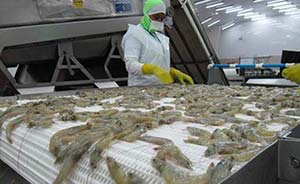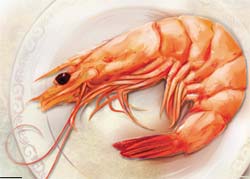While some shrimp exporters to the United States as well as importers are concerned about the potential commercial impact from the inclusion of shrimp in seafood traceability rules as part of the US Senate Appropriations Bill, producers in Ecuador are not among them.
 This frozen shrimp plant in Ecuador utilizes state-of-the art equipment to process top-quality raw material sourced from nearby farms.“We are very pleased to see the announcement that shrimp will be added to the US Seafood Import Monitoring Program, as we firmly believe it’s time for responsible producers to stand up in favor of strong standards and improved traceability in the seafood industry,” stated José Antonio Camposano, executive president of the National Chamber of Aquaculture of Ecuador, on August 1. “All consumers deserve access to the highest quality products, and through this program US consumers will have improved knowledge and access to shrimp produced to the highest environmental and social standards.”
This frozen shrimp plant in Ecuador utilizes state-of-the art equipment to process top-quality raw material sourced from nearby farms.“We are very pleased to see the announcement that shrimp will be added to the US Seafood Import Monitoring Program, as we firmly believe it’s time for responsible producers to stand up in favor of strong standards and improved traceability in the seafood industry,” stated José Antonio Camposano, executive president of the National Chamber of Aquaculture of Ecuador, on August 1. “All consumers deserve access to the highest quality products, and through this program US consumers will have improved knowledge and access to shrimp produced to the highest environmental and social standards.”
Even happier with the bill is the Biloxi, Mississippi-based American Shrimp Processors Association (ASPA). It promotes the interests of the domestic wild-caught, warm water shrimp processing industry along the US Gulf Coast. Imports are competition for members of the organization, who hail from Texas, Louisiana, Mississippi, Alabama and Florida. With a collective payroll topping $30 million per annum, they provide jobs for more than 13,000 Americans.
 “We are so pleased that Chairmen Thad Cochran (Republican of Mississippi) and Richard Shelby (Republican of Alabama) inserted language in the Senate CJS (Commerce, Justice and Science Subcommittee) Appropriations Bill to make sure that shrimp is included in this important program to provide traceability of US seafood imports,” said Dr. David Veal, ASPA’s executive director. “They understand that since shrimp comprises 65% of US seafood imports, it is vital that the species is included in the program.”
“We are so pleased that Chairmen Thad Cochran (Republican of Mississippi) and Richard Shelby (Republican of Alabama) inserted language in the Senate CJS (Commerce, Justice and Science Subcommittee) Appropriations Bill to make sure that shrimp is included in this important program to provide traceability of US seafood imports,” said Dr. David Veal, ASPA’s executive director. “They understand that since shrimp comprises 65% of US seafood imports, it is vital that the species is included in the program.”
The US trade deficit in shrimp was reportedly about $4.5 billion in 2016. The vast majority of imports are received in frozen form, with India, Indonesia, Thailand, Vietnam, Mexico, China and Malaysia listed among 13 countries with which the US recorded a significant overall shrimp trade deficit last year.
Senator Cochran’s provision instructs the National Oceanic and Atmospheric Administration (NOAA) to lift a directive imposed by the Administration of former President Obama that excluded shrimp from the Seafood Import Monitoring Program.
“This provision sends a signal that the Senate is serious about protecting consumers, while leveling the playing field for our domestic shrimpers harmed by illegal and unfair foreign competition,” stated Cochran. “Imported shrimp should be included in the enforcement of US trade laws, particularly since violations of those laws are well documented.”
No Problemo for Ecuador
Assuming that the language inserted by Cochran into the bill remains intact, imports of both wild-caught and farmed shrimp will be subject to US seafood traceability rules on January 1, 2018. That’s no problemo for Ecuadorian exporters.
According to statistics published by Urner Barry, a food commodity market information service, producers in Ecuador exported almost 15 million pounds of shrimp to the United States in May, while European buyers took 20.59 million pounds. Asia, driven by growing shipments to China, absorbed almost 49% of production.
Aquaculture overwhelmingly accounts for Ecuador’s growing shrimp industry output, which generates annual revenues of approximately $3 billion. The nation is currently leading a new antibiotic-free initiative aimed to further improve its position as a provider of premium shrimp.
India is Top Exporter
India, which has ranked as the biggest exporter of shrimp to the United States in recent years, shipped 30.5 million pounds to the US in April. For the first four months of the year Indian producers have moved 110 million pounds to the American market, according to Urner Barry.
India’s rise to become the leading supplier of shrimp to the United States came in the wake of Early Mortality Syndrome (EMS) outbreaks at farms in Thailand (the former No. 1 supplier to the US), Vietnam and other Asia-Pacific countries.
Accounting for approximately 70% of almost $6 billion in annual exports of marine products, the cultured shrimp industry is huge in India. Approximately one-third of its output currently goes to the United States.
 “Our shrimps are enjoying good acceptance in the US,” said Kenny Thomas, an exporter and vice president of the Seafood Exporters Association of India. “There is no threat, even if Thailand recovers its production fully, as our shrimps enjoy good recall value now.”
“Our shrimps are enjoying good acceptance in the US,” said Kenny Thomas, an exporter and vice president of the Seafood Exporters Association of India. “There is no threat, even if Thailand recovers its production fully, as our shrimps enjoy good recall value now.”
Rahul Kulkarni, director of the WestCoast Group, a major seafood exporter from India, commented: “With exports to the US setting new records and the market’s rising appetite, the industry is confident of strong growth for Indian shrimp. By our current estimates, it would be a surprise if Indian exports don’t bring in year-on-year growth in excess of 20%.”





